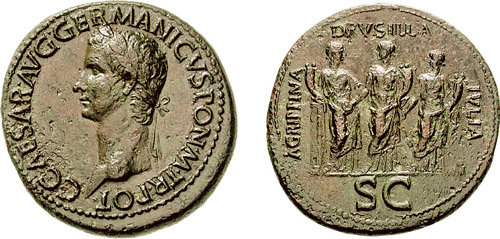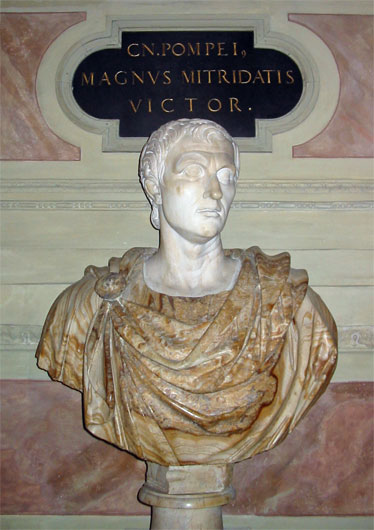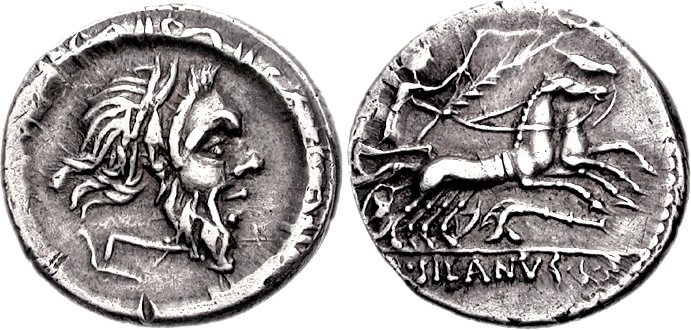|
Lucius Junius Silanus Torquatus
Two noblemen, an uncle and nephew, who shared the name Lucius Junius Silanus Torquatus and were descendants of the Roman Emperor Augustus, lived during the 1st century AD. Elder Silanus Silanus (died 49), was the third born son to Aemilia Lepida and Marcus Junius Silanus Torquatus, a member of the Junii Silani, a family of Ancient Rome. His maternal grandparents were Julia the Younger, granddaughter of Augustus, and consul Lucius Aemilius Paullus. Through his maternal grandparents he was a descendant of the Roman Emperor Augustus, the noble woman Scribonia, the statesman Marcus Vipsanius Agrippa and the consul Lucius Aemilius Lepidus Paullus (brother of the triumvir Marcus Aemilius Lepidus). He won an honorary triumph and gave a lavish gladiatorial display. He was praetor in 48. The Emperor Claudius betrothed him to his daughter Claudia Octavia, but this was broken off (also in 48) when the Empress Agrippina the Younger, hoping to secure Octavia as bride for her son Nero and ... [...More Info...] [...Related Items...] OR: [Wikipedia] [Google] [Baidu] |
Augustus
Caesar Augustus (born Gaius Octavius; 23 September 63 BC – 19 August AD 14), also known as Octavian, was the first Roman emperor; he reigned from 27 BC until his death in AD 14. He is known for being the founder of the Roman Principate, which is the first phase of the Roman Empire, and Augustus is considered one of the greatest leaders in human history. The reign of Augustus initiated an imperial cult as well as an era associated with imperial peace, the ''Pax Romana'' or ''Pax Augusta''. The Roman world was largely free from large-scale conflict for more than two centuries despite continuous wars of imperial expansion on the empire's frontiers and the year-long civil war known as the "Year of the Four Emperors" over the imperial succession. Originally named Gaius Octavius, he was born into an old and wealthy equestrian branch of the plebeian ''gens'' Octavia. His maternal great-uncle Julius Caesar was assassinated in 44 BC, and Octavius was named in Caesar' ... [...More Info...] [...Related Items...] OR: [Wikipedia] [Google] [Baidu] |
Agrippina The Younger
Julia Agrippina (6 November AD 15 – 23 March AD 59), also referred to as Agrippina the Younger, was Roman empress from 49 to 54 AD, the fourth wife and niece of Emperor Claudius. Agrippina was one of the most prominent women in the Julio-Claudian dynasty. She was the daughter of the Roman general Germanicus and Agrippina the Elder, granddaughter of Augustus (the first Roman emperor). Her father, Germanicus, was the nephew and heir apparent of the second emperor, Tiberius. Agrippina's brother Caligula became emperor in 37 AD. After Caligula was assassinated in 41 AD, Germanicus' brother Claudius took the throne. Agrippina married Claudius in 49 AD. Agrippina functioned as a behind-the-scenes advisor in the affairs of the Roman state via powerful political ties. She maneuvered her son Nero into the line of succession. Claudius became aware of her plotting, but died in 54; it was rumoured that Agrippina poisoned him.Tacitus, ''Annals'' XII.66; Cassius Dio, ''Roman History'' LXI.3 ... [...More Info...] [...Related Items...] OR: [Wikipedia] [Google] [Baidu] |
Tacitus
Publius Cornelius Tacitus, known simply as Tacitus ( , ; – ), was a Roman historian and politician. Tacitus is widely regarded as one of the greatest Roman historiography, Roman historians by modern scholars. The surviving portions of his two major works—the Annals (Tacitus), ''Annals'' (Latin: ''Annales'') and the Histories (Tacitus), ''Histories'' (Latin: ''Historiae'')—examine the reigns of the Roman emperor, emperors Tiberius, Claudius, Nero, and those who reigned in the Year of the Four Emperors (69 AD). These two works span the history of the Roman Empire from the death of Augustus (14 AD) to the death of Domitian (96 AD), although there are substantial Lacuna (manuscripts), lacunae in the surviving texts. Tacitus's other writings discuss Public speaking, oratory (in dialogue format, see ''Dialogus de oratoribus''), Germania (in Germania (book), ''De origine et situ Germanorum''), and the life of his father-in-law, Gnaeus Julius Agricola, Agricola (t ... [...More Info...] [...Related Items...] OR: [Wikipedia] [Google] [Baidu] |
De Vita Caesarum
''De vita Caesarum'' (Latin; "About the Life of the Caesars"), commonly known as ''The Twelve Caesars'', is a set of twelve biographies of Julius Caesar and the first 11 emperors of the Roman Empire written by Gaius Suetonius Tranquillus. The group are: Julius Caesar (d. 44 BC), Augustus, Tiberius, Caligula, Claudius, Nero, Galba, Otho, Vitellius, Vespasian, Titus, Domitian (d. 96 AD). The work, written in AD 121 during the reign of the emperor Hadrian, was the most popular work of Suetonius, at that time Hadrian's personal secretary, and is the largest among his surviving writings. It was dedicated to a friend, the Praetorian prefect Gaius Septicius Clarus. ''The Twelve Caesars'' was considered very significant in antiquity and remains a primary source on Roman history. The book discusses the significant and critical period of the Principate from the end of the Republic to the reign of Domitian; comparisons are often made with Tacitus, whose surviving works document a ... [...More Info...] [...Related Items...] OR: [Wikipedia] [Google] [Baidu] |
Suetonius
Gaius Suetonius Tranquillus (), commonly referred to as Suetonius ( ; c. AD 69 – after AD 122), was a Roman historian who wrote during the early Imperial era of the Roman Empire. His most important surviving work is a set of biographies of 12 successive Roman rulers, from Julius Caesar to Domitian, properly entitled ''De vita Caesarum''. Other works by Suetonius concerned the daily life of Rome, politics, oratory, and the lives of famous writers, including poets, historians, and grammarians. A few of these books have partially survived, but many have been lost. Life Gaius Suetonius Tranquillus was probably born about AD 69, a date deduced from his remarks describing himself as a "young man" 20 years after Nero's death. His place of birth is disputed, but most scholars place it in Hippo Regius, a small north African town in Numidia, in modern-day Algeria. It is certain that Suetonius came from a family of moderate social position, that his father, Suetonius Laetus, ... [...More Info...] [...Related Items...] OR: [Wikipedia] [Google] [Baidu] |
Junia (gens)
The gens Junia was one of the most celebrated families of ancient Rome. The gens may originally have been patrician, and was already prominent in the last days of the Roman monarchy. Lucius Junius Brutus was the nephew of Lucius Tarquinius Superbus, the seventh and last King of Rome, and on the expulsion of Tarquin in 509 BC, he became one of the first consuls of the Roman Republic.''Dictionary of Greek and Roman Biography and Mythology'', vol. II, p. 658 ("Junia Gens"). Over the next several centuries, the Junii produced a number of very eminent men, such as Gaius Junius Bubulcus Brutus, three times consul and twice dictator during the period of the Samnite Wars, as well as Marcus and Decimus Junius Brutus, among the leaders of the conspiracy against Caesar. Although the Junii Bruti disappeared at the end of the Republic, another family, the Junii Silani, remained prominent under the early Empire. Origin ''Junius'', the nomen of the gens, may be etymologically connected ... [...More Info...] [...Related Items...] OR: [Wikipedia] [Google] [Baidu] |
Apulia
it, Pugliese , population_note = , population_blank1_title = , population_blank1 = , demographics_type1 = , demographics1_footnotes = , demographics1_title1 = , demographics1_info1 = , demographics1_title2 = , demographics1_info2 = , demographics1_title3 = , demographics1_info3 = , timezone1 = CET , utc_offset1 = +01:00 , timezone1_DST = CEST , utc_offset1_DST = +02:00 , postal_code_type = , postal_code = , area_code_type = ISO 3166 code , area_code = IT-75 , blank_name_sec1 = GDP (nominal) , blank_info_sec1 = €76.6 billion (2018) , blank1_name_sec1 = GDP per capita , blank1_info_sec1 = €19,000 (2018) , blank2_name_sec1 = HDI (2018) , blank2_info_sec1 = 0.845 · 18th of 21 , blank_name_sec2 = NUTS Region , blank_info_sec2 = ... [...More Info...] [...Related Items...] OR: [Wikipedia] [Google] [Baidu] |
Bari
Bari ( , ; nap, label= Barese, Bare ; lat, Barium) is the capital city of the Metropolitan City of Bari and of the Apulia region, on the Adriatic Sea, southern Italy. It is the second most important economic centre of mainland Southern Italy after Naples. It is a port and university city, as well as the city of Saint Nicholas. The city itself has a population of 315,284 inhabitants, over , while the urban area has 750,000 inhabitants. The metropolitan area has 1.3 million inhabitants. Bari is made up of four different urban sections. To the north is the closely built old town on the peninsula between two modern harbours, with the Basilica of Saint Nicholas, the Cathedral of San Sabino (1035–1171) and the Hohenstaufen Castle built for Frederick II, which is now also a major nightlife district. To the south is the Murat quarter (erected by Joachim Murat), the modern heart of the city, which is laid out on a rectangular grid-plan with a promenade on the sea and the majo ... [...More Info...] [...Related Items...] OR: [Wikipedia] [Google] [Baidu] |
Gaius Cassius Longinus (consul 30)
Gaius Cassius Longinus was a Roman jurist and politician from the first century AD. A grandnephew of Servius Sulpicius Rufus, he was also a nephew or great-grandson of Gaius Cassius Longinus, one of Caesar's assassins. Longinus was suffect consul of the second half of the year 30 as the colleague of Lucius Naevius Surdinus. Cassius, a pupil of Sabinus, was head of the legal school called the Sabinians or Cassinians. His principal works are the ''libri (commentarii) iuris civilis'' in at least ten volumes, which only survive in quotes by later authors such as Iavolenus. After completing his term as suffect consul, Longinus served as proconsular governor of Asia minor in 40–41, then governor of the imperial province of Syria in 41–49. He was exiled by Nero to Sardinia in 65, but returned to Rome when Vespasian acceded to the purple. Tacitus includes a speech of Cassius, when he was a senator in the time of Nero, on the debate that arose when there had been mass protests in R ... [...More Info...] [...Related Items...] OR: [Wikipedia] [Google] [Baidu] |
Junia Lepida
Junia Lepida (c. AD 18 - 65) was a Roman noblewoman who lived in the first century. Life She was the second daughter of Aemilia Lepida and Marcus Junius Silanus Torquatus, one of the Junii Silani. Her maternal grandparents were Julia the Younger, granddaughter of the emperor Augustus, and Lucius Aemilius Paullus, consul in AD 1. Lepida married Gaius Cassius Longinus (c. 13 BC - AD 69), a person with remarkable ancestral wealth. Cassius was praefectus urbi circa AD 27, consul ''suffectus'' in AD 30, proconsul of Asia in 40 or 41, and governor of Syria between about AD 45 and 49. Lepida and Cassius raised Lepida's nephew, Lucius Junius Silanus Torquatus, whose father was murdered by Empress Agrippina the Younger. In AD 66, Lepida's husband and nephew were expelled from Rome by Emperor Nero for being a part in Gaius Calpurnius Piso's conspiracy. Cassius was deported to Sardinia. Lepida was accused by Nero of black magic and incest with her nephew; her subsequent fate is unknown. ... [...More Info...] [...Related Items...] OR: [Wikipedia] [Google] [Baidu] |
Marcus Junius Silanus Torquatus (consul AD 46)
Marcus Junius Silanus (AD 14–54) was a Roman senator. Biography He was the eldest son of Marcus Junius Silanus Torquatus and Aemilia Lepida (fiancee of Claudius), Aemilia Lepida. His mother was the great-granddaughter of the emperor Augustus. As a member of the imperial family, Silanus could therefore be considered a possible candidate for the succession. Although he was honoured with a consulship by the Emperor Claudius in 46, and served as proconsular governor of Asia (Roman province), Asia, Silanus did not survive the death of that Emperor. Although Tacitus exonerates Nero of Silanus' death, the 'first crime of the new principate,' the historian casts Agrippina, Nero's mother, as the architect of the murder, on the grounds that she feared that Silanus would avenge his brother's death, of which she was the perpetrator.''Annales'' 13.1 As with Claudius, poison was the means to Silanus' end; the epitomator of Dio Cassius' ''Roman History'' tells us that Agrippina sent Silanus th ... [...More Info...] [...Related Items...] OR: [Wikipedia] [Google] [Baidu] |
New Year's Day
New Year's Day is a festival observed in most of the world on 1 January, the first day of the year in the modern Gregorian calendar. 1 January is also New Year's Day on the Julian calendar, but this is not the same day as the Gregorian one. Whilst most solar calendars (like the Gregorian and Julian) begin the year regularly at or near the northern winter solstice, cultures that observe a lunisolar or lunar calendar celebrate their New Year (such as the Chinese New Year and the Islamic New Year) at less fixed points relative to the solar year. In pre-Christian Rome under the Julian calendar, the day was dedicated to Janus, god of gateways and beginnings, for whom January is also named. From Roman times until the middle of the 18th century, the new year was celebrated at various stages and in various parts of Christian Europe on 25 December, on 1 March, on 25 March and on the movable feast of Easter. In the present day, with most countries now using the Gregorian calendar ... [...More Info...] [...Related Items...] OR: [Wikipedia] [Google] [Baidu] |






.jpg)

